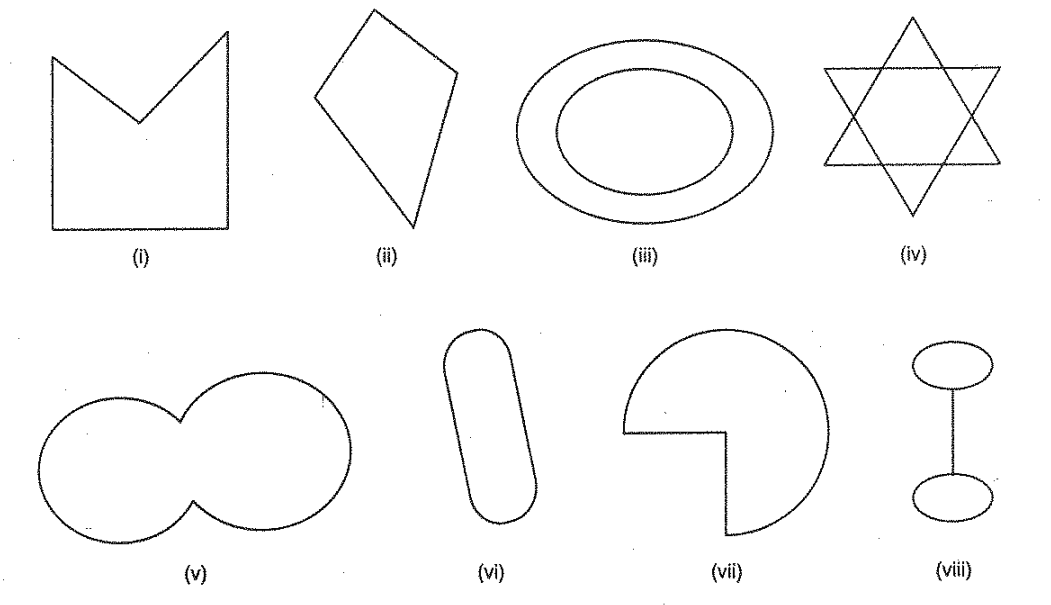Draw rough diagrams to illustrate the following: (i) Open curve (ii) Closed curve
Step-by-Step Text Solution:
Step 1: Understanding Open Curves
- An open curve is a type of curve that does not intersect itself. This means that if you were to draw it, the line would not connect back to itself at any point.
Step 2: Drawing an Open Curve
- To illustrate an open curve, you can draw a simple wavy line that starts at one point and ends at another without looping back. For example, you can draw a line that goes up and down but does not connect back to the starting point.
Example of Open Curve:
///
Step 3: Understanding Closed Curves
- A closed curve is a curve that intersects itself at least at one point, effectively forming a complete loop. This means that the starting point and the ending point of the curve are the same.
Step 4: Drawing a Closed Curve
- To illustrate a closed curve, you can draw a circle or any shape that loops back to its starting point. For example, you can draw a circle or an oval shape.
Example of Closed Curve:
−−−−−∣∣ −−−−−
- An open curve is a type of curve that does not intersect itself. This means that if you were to draw it, the line would not connect back to itself at any point.
- To illustrate an open curve, you can draw a simple wavy line that starts at one point and ends at another without looping back. For example, you can draw a line that goes up and down but does not connect back to the starting point.
///
- A closed curve is a curve that intersects itself at least at one point, effectively forming a complete loop. This means that the starting point and the ending point of the curve are the same.
- To illustrate a closed curve, you can draw a circle or any shape that loops back to its starting point. For example, you can draw a circle or an oval shape.
−−−−−∣∣ −−−−−
Topper's Solved these Questions
Similar Questions
Following are some figures: Classify each of these figures on the basis of the following:(i) Simple curve (ii) Simple closed curve (iii) Polygon (iv) Convex polygon (v)Concave polygon (vi) Not a curve

View SolutionA box contains 3 blue, 2 white, and 4 red marbles. If a marble is drawn at random from the box, what is the probability that it will be(i) white? (ii) blue? (iii) red?
View Solution
Knowledge Check
The mean of 100 numbers observations is 50 and their standards deviation is 5. The sum of all squares of all the observations is
A50,000B250,000C252500D255000
What is a regular polygon? State the name of a regular polygon of
(i) 3 sides
(ii) 4 sides
(iii) 6 sides
View SolutionA family has 2 children. Find the probability that both are boys, if it is known that: (i) at least one of the children is a boy, (ii) the elder child is a boy.
View SolutionFind the volume in cubic decimetre of each of the cubes whose side is (i)1.5m (ii) 75cm (iii) 2dm 5cm
View SolutionHow many diagonals does each of the following have?
(i) A convex quadrilateral
(ii) A regular hexagon
(iii) A triangle
View SolutionThe co-ordinates of two fixed points A and B of a triangle ABC are (a,0) and (−a,0) respectively. If variable point C moves such that cotA+cotB=λ, (where λ is a constant) then the locus of point C is:-
(1) yλ=2a (2) y=λa
(3) ya=2λ (4) None of these.
View SolutionThe distance of the point (2,3) from the line x−2y+5=0 measured in a direction parallel to the line x−3y=0 is:
(A) 2√10 (B) √10 (C) 2√5 (D) None of these
View SolutionWhen a die is thrown, list the outcomes of an event of getting
(i) (a) a prime number (b) not a prime number.
(ii) (a) a number greater than 5 (b) a number not greater than 5.
View Solution
